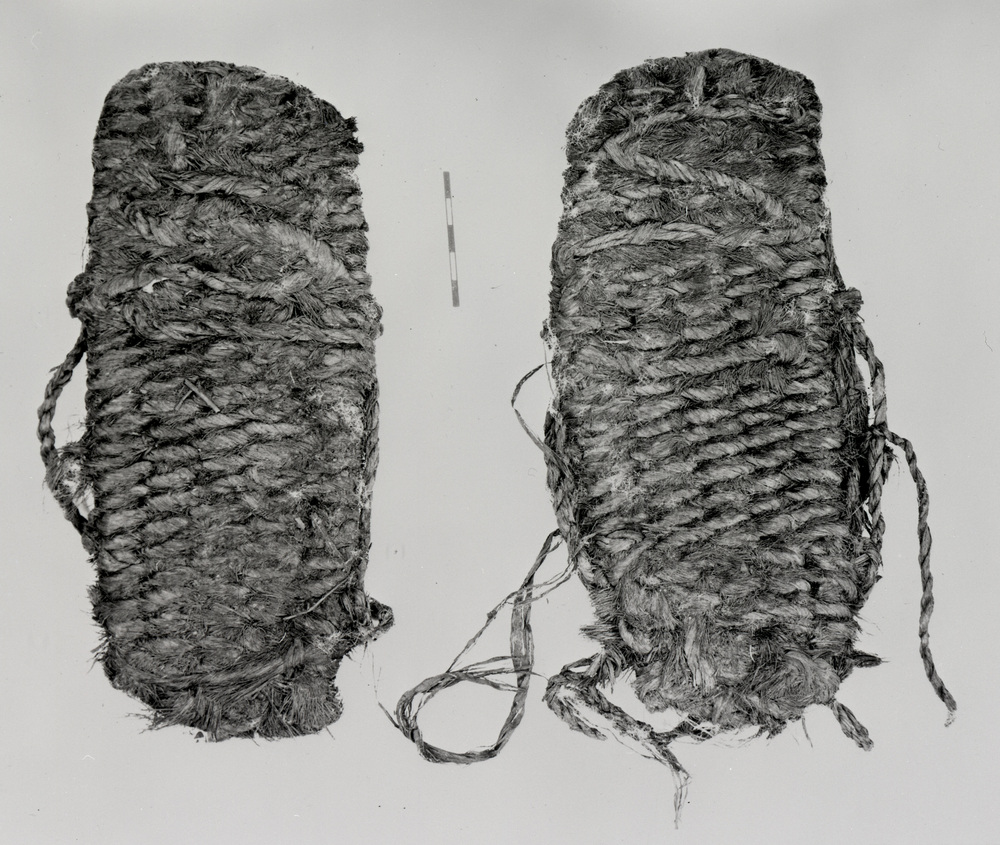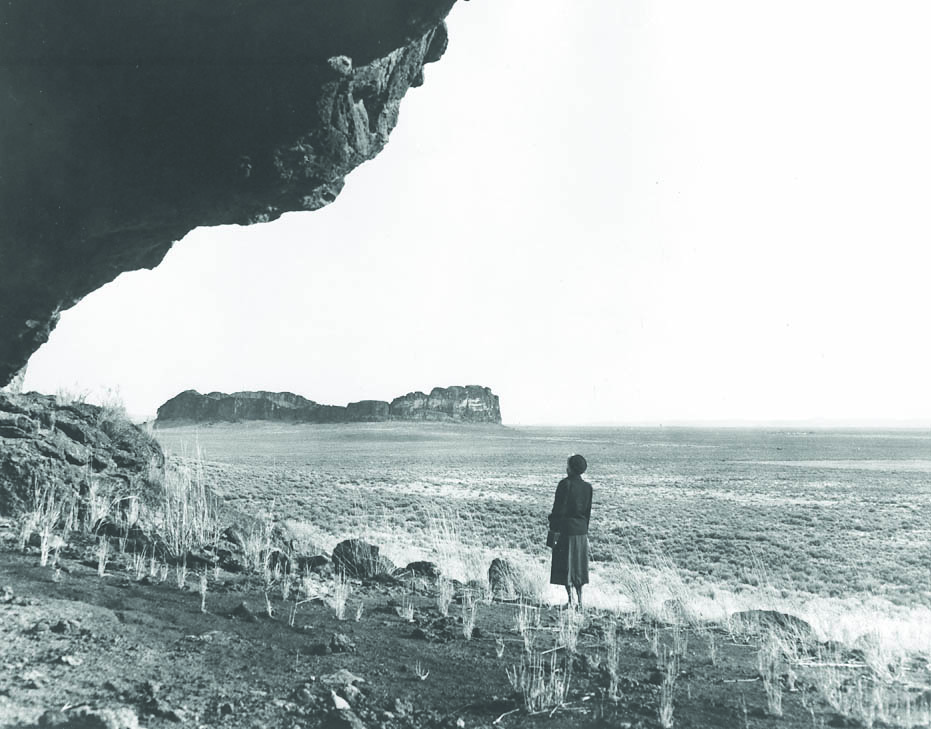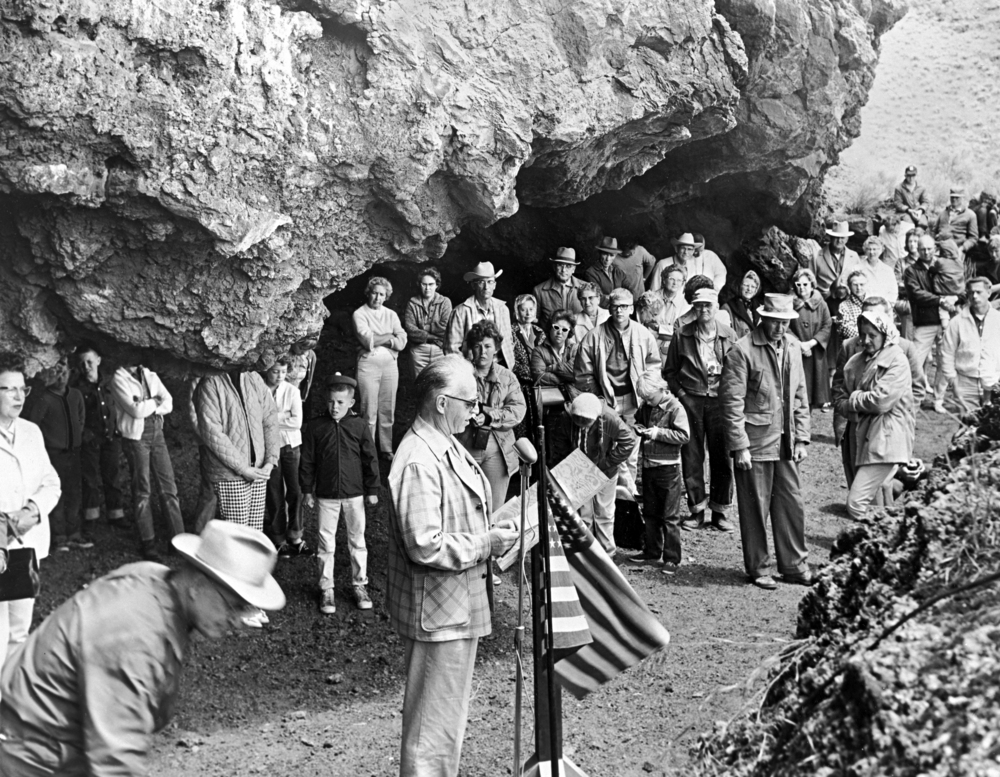Fort Rock sandals are a distinctive type of ancient fiber footwear found in southeast Oregon and northern Nevada. Named by archaeologist Luther Cressman, who first found examples in Oregon’s Fort Rock Cave, Fort Rock sandals are the oldest directly dated footwear in the world.
In 1938, anthropologist Luther Cressman from the University of Oregon recovered dozens of sandals and fragments of sandals from Fort Rock Cave. They were found beneath a layer of volcanic ash, which was later identified as coming from the eruption of Mount Mazama approximately 7,600 BP. Cressman believed that the sandals were ancient, but because radiocarbon dating would not be developed for another decade, his conviction would not be confirmed until 1951, when fibers from the sandals themselves were dated to more than 9,000 years old.
All of the Fort Rock Cave sandals were of the same distinctive style, with a flat sole and toe flap covering the top of the foot. The Fort Rock sandals represented one of three sandal forms identified by Cressman during his archaeological research at other northern Great Basin sites. He called the style found at Fort Rock Cave the Fort Rock Type; the others, Multiple Warp and Spiral Weft types, were named for structural features and generally post-date the Fort Rock sandals.
Fort Rock sandals are made of shredded sagebrush bark. They are twined, with pairs of fiber wefts twisted around passive warps, in contrast to simple over-and-under interlacing or plaiting, known as wickerwork. The foundation of the flat sole is five thick warps, consisting of two long ropes folded into a parabola (U-shape) at the heel and a single central warp. Construction begins at the heel by twining pairs of fibers (wefts) back and forth across the sole. Each weft row is packed tightly against the previous row (close twining) to completely cover the warp and add strength to the sole.
Twining continues from heel to toe until the desired length is achieved. At the toe, the thick warp fibers are subdivided into finer cords, folded back over the top of the sole, and twined back and forth to form a toe flap. Space is left between the weft rows, with the warp cords visible (open twining) and the edges of the toe flap secured to the edges of the sole.
The tie system involves a series of interlocking loops fixed to the edge of the sole near the heel. A tie rope attached to the other edge is passed through the heel loop and cinched tight around the ankle.
While sandals have been found at sites other than Fort Rock Cave, no other site has produced the unusual quantity found at Fort Rock. They range from child-size to large adult size. Most are heavily worn or broken, which suggests that they were discarded rather than being stored for later use.
Fort Rock-style sandals have been found at six other sites in southeast Oregon and northwestern Nevada, and fibers from more than twenty individual sandals from seven different sites have been radiocarbon dated. Their ages range from about 10,400 to 9,100 years old, making Fort Rock sandals the oldest directly dated footwear in the world.
Fort Rock sandals may have been winter wear. Ethnographers have documented Klamath and Paiute Indians, who lived in the Fort Rock area in more recent times, making shoes from tule reeds and sagebrush bark, sometimes stuffed with dry grass for insulating warmth to protect feet in icy marsh waters.
The largest collection of Fort Rock sandals is located at the University of Oregon Museum of Natural & Cultural History; others are housed at the Nevada State Museum, the Klamath and Lake County museums, and the Oregon Historical Society. Research continues on the sandals and the cave sites where they were found; many Fort Rock sandals (and other fiber artifacts) have been radiocarbon dated in recent years, and the caves that Cressman explored in the 1930s have produced some of the earliest evidence for human occupation in North America.
-
![Sagebrush sandals excavated at Fort Rock Cave by Dr. Luther Cressman, 1938.]()
Fort Rock sandals, 1938, bb006673.
Sagebrush sandals excavated at Fort Rock Cave by Dr. Luther Cressman, 1938. Luther Cressman photo, courtesy Oreg. Hist. Soc. Research Lib., bb006673
-
![Fort Rock Cave opening, 1966]()
Fort Rock Cave opening, 1966.
Fort Rock Cave opening, 1966 Courtesy Oreg. Hist. Soc. Research Lib. OrHi80012
-
![Fort Rock sandal, ca 9490 yrs ago (l); Catlow sandal, 9300 yrs ago (r)]()
Fort Rock sandal (left); Catlow Cave sandal (right).
Fort Rock sandal, ca 9490 yrs ago (l); Catlow sandal, 9300 yrs ago (r) Courtesy UOMNCH
-
![Fort Rock Cave, c. 1966]()
Fort Rock Cave, c. 1966.
Fort Rock Cave, c. 1966 Courtesy UOMNCH
-
![Early tools excavated from Fort Rock Cave]()
Early tools from Fort Rock Cave.
Early tools excavated from Fort Rock Cave Courtesy UOMNCH
Related Entries
-
![Fort Rock Cave]()
Fort Rock Cave
Fort Rock Cave is located in a small volcanic butte approximately half …
-
![Luther Cressman (1897-1994)]()
Luther Cressman (1897-1994)
Known as the father of Oregon archaeology and anthropology, Luther Cres…
-
![Mount Mazama]()
Mount Mazama
Mount Mazama is located in the southern part of the Cascade Range, abou…
Map This on the Oregon History WayFinder
The Oregon History Wayfinder is an interactive map that identifies significant places, people, and events in Oregon history.
Further Reading
Adovasio, James M. "Prehistoric Basketry." In Great Basin: Handbook of North American Indians, Volume 11, edited by Warren L. d’Azevedo, pp. 194-205. Washington, D.C.: Smithsonian Institution, 1986.
Connolly, Thomas J. and Pat Barker (2008) Great Basin Sandals. In The Great Basin: People and Place in Ancient Times, edited by Catherine S. Fowler and Don D. Fowler, pp. 68-73. School for Advanced Research Press, Santa Fe, New Mexico.
Cressman, Luther S. "Western Prehistory in the Light of Carbon-14 Dating." Southwestern Journal of Anthropology 7.3 (1951): 289-313.
Cressman, Luther S. Archaeological Researches in the Northern Great Basin. Washington, D.C.: Carnegie Instilution of Washington Publication 538, 1942.
Cressman, Luther S. The Sandal and the Cave: The Indians of Oregon. Corvallis: Oregon State University Press, 2005
Jenkins, Dennis L., and others. "Geochronology, Archaeological Context, and DNA at the Paisley Caves." In Paleoamerican Odyssey, edited by Kelly E. Graf, Caroline V. Ketron, and Michael R. Waters, pp. 485-510. College Station, Tex.: Center for the Study of the First Americans, 2013.










